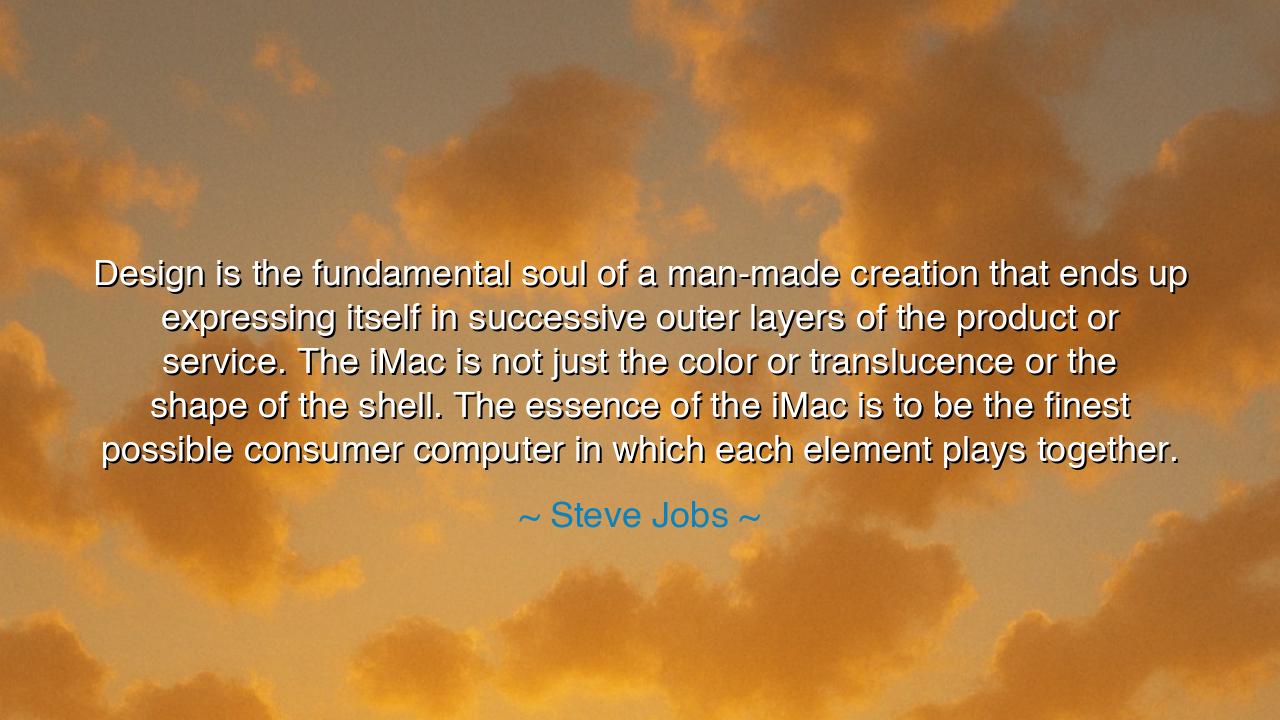
Design is the fundamental soul of a man-made creation that ends
Design is the fundamental soul of a man-made creation that ends up expressing itself in successive outer layers of the product or service. The iMac is not just the color or translucence or the shape of the shell. The essence of the iMac is to be the finest possible consumer computer in which each element plays together.






Steve Jobs’ words, “Design is the fundamental soul of a man-made creation that ends up expressing itself in successive outer layers of the product or service. The iMac is not just the color or translucence or the shape of the shell. The essence of the iMac is to be the finest possible consumer computer in which each element plays together,” echo with a profound truth about the very nature of creation. In these words, Jobs speaks not just of aesthetic or form, but of essence, of purpose, of the soul embedded in every creation. Design, according to Jobs, is not a superficial afterthought—it is the very heartbeat of the creation, the underlying spirit that breathes life into the final product, weaving form and function into a seamless harmony.
The concept of design as soul is not new, for the ancients too understood that true creation is not just the sum of its parts. Consider the Greek philosophers, who saw beauty and form as reflections of the divine order of the universe. Plato, in his dialogues, spoke of the Forms—perfect, eternal ideals that transcended the physical world. In the same way, Jobs saw design as a reflection of an ideal, a pure and perfect vision of what a product could be. The iMac was not just a computer, but an expression of the perfect harmony between form and function. Its design, from the translucence of its shell to the way its components interacted, was an embodiment of a higher ideal of user experience and technology.
To understand the depth of Jobs’ vision, we must look to the ancient craftsmen who shaped the world around them with similar care and reverence. Phidias, the great sculptor of ancient Greece, did not simply carve stone—he imbued it with meaning. His statues, such as the Parthenon Marbles, were not mere depictions of the human form; they were representations of the divine, of ideals that transcended the physical world. Jobs, like Phidias, saw his creations not as mere objects, but as expressions of something deeper—a philosophy, a purpose, a vision of what the world could be when art and science worked together in harmony. The iMac, like Phidias’ statues, was a vessel for this vision—a perfect, harmonious creation in which each element played its part.
This is the essence of Jobs’ philosophy: design is not just about the outer shell—the color, the shape, the materials. It is about the soul that underlies it all, the unseen, intangible force that makes the product not just a tool, but a reflection of human aspiration. Just as the ancients imbued their works with a sense of the divine, so did Jobs imbue the iMac with a sense of purpose—the goal of making technology not just functional, but beautiful, intuitive, and ultimately, human. It was not enough for the iMac to work well; it had to feel right, to feel inspired.
This idea of design as soul also speaks to the very nature of human creativity. Think of Leonardo da Vinci, whose inventions and artworks were not simply creations of the mind, but expressions of his soul. Da Vinci’s drawings were not just technical illustrations; they were reflections of his vision of the world—a world where art and science were intertwined, each informing and elevating the other. The iMac, in its design, carries the same spirit. It is a tool, yes, but it is also a work of art, a piece of technology that transcends its function to become something greater—a symbol of human potential and creativity.
The lesson in Jobs’ words is profound. It teaches us that true creation does not come from simply assembling parts or focusing solely on function; it comes from the understanding that form and function must work together in harmony. It teaches us that every creation—whether it be in technology, art, or any field of human endeavor—should embody purpose, vision, and soul. It is not enough to create something that works; one must create something that resonates with the human spirit, something that touches the soul and elevates the everyday.
Lesson for the ages:
True design is not just about appearance—it is about purpose and essence. Every creation is a reflection of the human spirit, and it is through design that we give life to our highest ideals. Whether in technology, art, or science, the greatest works are those in which form and function are harmonized, where each element plays a part in a greater whole. To create something truly meaningful, we must imbue it with vision, care, and a sense of purpose that transcends its utilitarian function.
Practical Action:
As you embark on your own creative journey, whether in business, art, or any field, remember the lesson of Steve Jobs. Strive not just to create something that works, but to create something that resonates with purpose and soul. Focus not only on the outer layers of your work—its form and aesthetics—but also on the essence that lies beneath. Whether you are designing a product, creating art, or crafting your life’s work, seek to bring together form and function in a way that reflects your highest ideals. Make your creations not just tools, but reflections of the divine potential that lies within us all.






AAdministratorAdministrator
Welcome, honored guests. Please leave a comment, we will respond soon